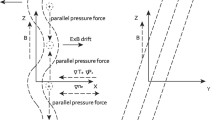Abstract
We consider the excitation and absorption of waves in a magnetoactive rf discharge plasma in the conditions when the generator frequency is lower than the electron cyclotron frequency. We consider the cases of unconfined and confined plasmas in the cylindrical geometry and different regimes of excitation of plasma waves with different dispersion relations and field polarizations. The power input to the plasma depends on the distribution of external-source currents initiating the discharge and on the density parameter characterizing the plasma density and transverse sizes of the system. In the case of a plasma cylinder with a free surface or a plasma cylinder in a large conducting casing, which is most interesting for applications, plasma contains only potential and nonpotential E-type oblique Langmuir waves as well as a strongly nonpotential surface wave. The latter wave is practically not excited by external currents flowing over the cylinder surface for real parameters of the system. For high values of the density parameter, the effective resistance of the plasma with inducting excitation of the discharge is predominant. For moderate and low values of this parameter, capacitive excitation of the wave by the current on the plasma cylinder surface is found to be most effective.












Similar content being viewed by others
Notes
The effective resistivity of the plasma defined in this way coincides with real part of the specific complex impedance of a plasma discharge, which has been calculated in [31].
REFERENCES
S. Shinohara, Adv. Phys. X 3, 1420424 (2018). https://doi.org/10.1080/23746149.2017.1420424
S. Isayama, S. Shinohara, and T. Hada, Plasma Fusion Res. 13, 1101014 (2018). https://doi.org/10.1585/pfr.13.1101014
F. F. Chen, Plasma Sources Sci. Technol. 24, 014001 (2015). https://doi.org/10.1088/0963-0252/24/1/014001
E. A. Kral’kina, Phys. Usp. 51, 493 (2008). https://doi.org/10.1070/PU2008v051n05ABEH006422
S. Samukawa et al., J. Phys. D: Appl. Phys. 45, 253001 (2012). https://doi.org/10.1088/0022-3727/45/25/253001
S. Shinohara et al., IEEE Trans. Plasma Sci. 42, 1245 (2014).
F. F. Chen, Phys. Plasmas 21, 093511 (2014). https://doi.org/10.1063/1.4896238
F. F. Chen, IEEE Trans. Plasma Sci. 43, 195 (2015).
S. Shinohara et al., IEEE Trans. Plasma Sci. 46, 252 (2018).
V. L. Vdovin, Plasma Phys. Rep. 39, 95 (2013). https://doi.org/10.1134/S1063780X13020037
C. Lau et al., Nucl. Fusion 58, 066004 (2018). https://doi.org/10.1088/1741-4326/aab96d
R. W. Boswell, Phys. Lett. A 33, 457 (1970). https://doi.org/10.1016/0375-9601(70)90606-7
R. W. Boswell, Plasma Phys. Control. Fusion 26, 1147 (1984).
R. W. Boswell, Austral. J. Phys. 25, 403 (1972). https://doi.org/10.1071/PH720403
R. W. Boswell, J. Plasma Phys. 31, 197 (1984). https://doi.org/10.1017/S0022377800001550
F. F. Chen, Plasma Phys. Control. Fusion 33, 339 (1991). https://doi.org/10.1088/0741-3335/33/4/006
K. P. Shamrai and V. B. Taranov, Plasma Phys. Control. Fusion 36, 1719 (1994).
D. Arnush, Phys. Plasmas 7, 3042 (2000). https://doi.org/10.1063/1.874157
E. A. Kralkina et al., AIP Adv. 8, 035217 (2018). https://doi.org/10.1063/1.5023631
H. Tamura et al., IEEE Trans. Plasma Sci. 46, 3662 (2018).
D. S. Stepanov, A. V. Chebotarev, and E. Y. Shkol’nikov, High Temp. 57, 316 (2019). https://doi.org/10.1134/S0018151X19030155
I. N. Kartashov and M. V. Kuzelev, High Temp. 56, 334 (2018). https://doi.org/10.1134/S0018151X18030100
I. N. Kartashov and M. V. Kuzelev, J. Exp. Theor. Phys. 129, 298 (2019). https://doi.org/10.1134/S106377611907015X
I. S. Abramov, E. D. Gospodchikov, and A. G. Shala-shov, J. Exp. Theor. Phys. 129, 444 (2019). https://doi.org/10.1134/S106377611907001X
E. A. Kralkina et al., Plasma Sources Sci. Technol. 26, 055006 (2017). https://doi.org/10.1088/1361-6595/aa61e6
E. A. Kralkina et al., Plasma Sources Sci. Technol. 25, 015016 (2016). https://doi.org/10.1088/0963-0252/25/1/015016
V. L. Ginzburg and A. A. Rukhadze, Waves in Magneto-Active Plasma (URSS, Moscow, 2013; Springer, New York, 1972).
A. F. Alexandrov, L. S. Bogdankevich, and A. A. Ru-khadze, Principles of Plasma Electrodynamics (Springer, Heidelberg, 1984; Vyssh. Shkola, Moscow, 1988).
M. V. Kuzelev, A. A. Rukhadze, and P. S. Strelkov, Plasma Relativistic Microwave Electronics (Lenand, Moscow, 2018) [in Russian].
M. V. Kuzelev and A. A. Rukhadze, Methods of Wave Theory in Dispersive Media (World Scientific, Singapore, 2010; Fizmatlit, Moscow, 2007).
A. F. Aleksandrov, M. V. Kuzelev, and A. A. Rukhadze, Commun. Technol. Electron. 55, 773 (2010).
K. P. Shamrai and V. B. Taranov, Plasma Sources Sci. Technol. 5, 474 (1996).
Funding
This study was supported by the Russian Foundation for Basic Research (project no. 19-08-00625).
Author information
Authors and Affiliations
Corresponding authors
Additional information
Translated by N. Wadhwa
Rights and permissions
About this article
Cite this article
Kartashov, I.N., Kuzelev, M.V. Mechanisms of Resonant Power Input into a Magnetoactive RF Discharge Plasma. J. Exp. Theor. Phys. 131, 645–663 (2020). https://doi.org/10.1134/S1063776120090162
Received:
Revised:
Accepted:
Published:
Issue Date:
DOI: https://doi.org/10.1134/S1063776120090162




